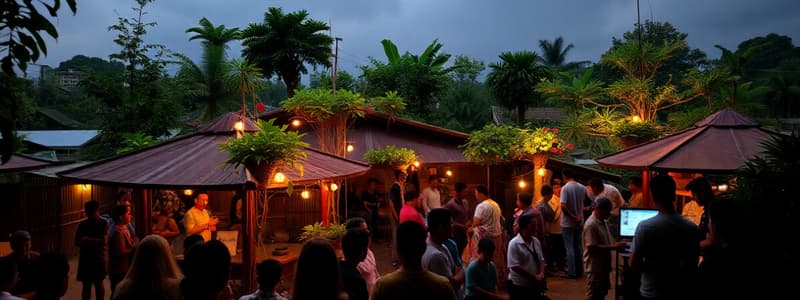Podcast
Questions and Answers
What defines culture in societies?
What defines culture in societies?
Societies personality
Which of the following are considered functional areas of culture? (Select all that apply)
Which of the following are considered functional areas of culture? (Select all that apply)
- Economics
- Ideology (correct)
- Social Structure (correct)
- Ecology (correct)
What is 'Ecology' in the context of culture?
What is 'Ecology' in the context of culture?
Resources, technology, use of space, cleanliness, attitude toward nature
Solar panels are mandatory on new builds in many states in Germany.
Solar panels are mandatory on new builds in many states in Germany.
Which country is noted for lagging in conservation efforts?
Which country is noted for lagging in conservation efforts?
What kind of arrangements are becoming more popular in domestic settings?
What kind of arrangements are becoming more popular in domestic settings?
In which type of culture is there a low power distance?
In which type of culture is there a low power distance?
In cultures with high uncertainty avoidance, there is a preference for __________.
In cultures with high uncertainty avoidance, there is a preference for __________.
The United States and Canada have notable differences in the femininity versus masculinity scale.
The United States and Canada have notable differences in the femininity versus masculinity scale.
What does collectivism emphasize in cultural values?
What does collectivism emphasize in cultural values?
Which term describes the process where consumption acquires symbolic meaning?
Which term describes the process where consumption acquires symbolic meaning?
What is 'product placement' in marketing?
What is 'product placement' in marketing?
Which is an example of discontinuous innovation?
Which is an example of discontinuous innovation?
Flashcards are hidden until you start studying
Study Notes
Culture
- A society's personality, acquired and learned through example.
- Defines boundaries and consequences for behavior.
Functional Areas of Culture
- Ecology
- Focuses on resources, technology, space use, cleanliness, and attitude towards nature.
- Examples:
- Canada's lag in conservation efforts, water insecurity projections, rooftop green initiatives in Toronto, and East Coast's hydropower potential.
- Germany's mandatory solar panels on new buildings.
- South Korea's technology advancements, government investments in internet infrastructure, and cultural spaces like the Starfield library.
- GMO concerns, Greenbelt Protection, North American cleanliness obsession, and Toronto's air quality in 2023.
- Pandemic impact on work-from-home, streaming services, and online shopping.
- Social Structure
- Examines political influence, such as the US's impact on Canadian trade.
- Examines domestic arrangements, highlighting the rise of multi-generational households and cultural differences in valuing elders (e.g., Indigenous, Mediterranean, Indian cultures).
- Ideology
- Encompasses culture, customs, and shared beliefs.
- Influences judgment, defining right/wrong, beauty/ugliness, etc.
- Examples: cultural significance of colors (e.g., red in China), gestures, eating habits.
Major Dimensions of Cultural Variance
- Power Distance
- Low PD: Loose hierarchies, considered "classless."
- High PD: Rigid hierarchies, status distinctions, and class divisions.
- Example: The caste system in India, Brazil's "haves and have-nots."
- Uncertainty Avoidance
- Measures tolerance for ambiguity and its management.
- Low UA: Embraces change, risk-taking, problem-solving, and secular values.
- High UA: Emphasizes tradition, security, fatalism, and religious values.
- Femininity vs. Masculinity
- Low M: Egalitarian, less rigid behavior codes.
- High M: Traditional gender roles, women at home, men at work.
- Example: Afghanistan.
- The US and Canada exhibit notable differences on this scale.
- Collectivism vs. Individualism
- Low I (Collectivist): Interdependent, cooperative, uniformity, postponed gratification.
- High I (Individualistic): Independent, competitive, diversity, immediate gratification.
- Self-Reference Criterion: The unconscious assumption that one's own culture is universal.
Creating and Diffusing Culture
- Cultural Selection:
- The gradual process where consumption possibilities acquire symbolic meaning and are adopted by consumers.
- Only a fraction of potential cultural elements reach end users.
- Subsystems Involved in Cultural Creation and Diffusion
- Creative Subsystem: Artists, scientists, inventors, the originators of ideas.
- Managerial Subsystem: Businesses and other entities that implement or manage ideas.
- Communications Subsystem: Advisors, media, marketing professionals.
- Formal Gatekeepers: Regulatory bodies, reviewers, professional associations.
- Informal Gatekeepers: Friends, family, style leaders, and opinion leaders.
- Marketing's Influence
- Increasingly involved in the creative subsystem, directly engaging with idea generation.
- Aesthetic market research to test plots, endings, etc.
- Reality Engineering: Utilizing popular culture elements to create physical or viewed environments. Examples: Epcot Center, West Edmonton Mall, Harry Potter World, indoor skiing in Dubai.
- Product Placement: Brands paying to be featured in movies, TV, and other content. Example: E.T. and Reese's Pieces.
Diffusion of Innovations
- Level of Innovation and Required Behavior Change:
- Continuous Innovation (Low): Minor adjustments to existing products.
- Dynamically Continuous Innovation (Moderate): Significant but familiar changes.
- Discontinuous Innovation (High): Radically new products or ideas that require substantial learning and adaptation.
- Examples of Innovations: InstaPot, internet of things, Tesla (consider pros and cons).
- Discontinuous Innovation: Loblaws utilizing autonomous vehicles.
Studying That Suits You
Use AI to generate personalized quizzes and flashcards to suit your learning preferences.





